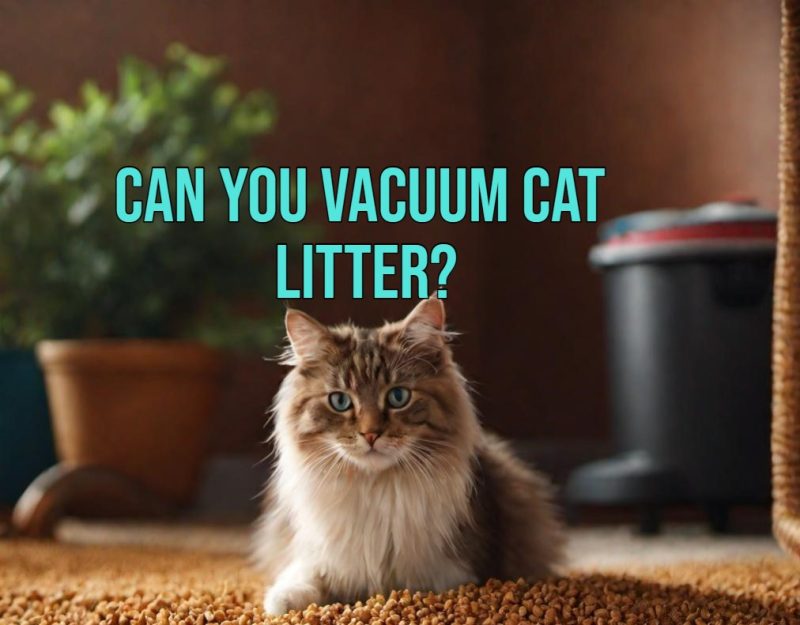Table of contents
Cat litter is an essential commodity for households with feline companions. It helps manage cat waste, keeps unpleasant odors at bay, and ensures a relatively clean environment for both the cat and its human family. But, accidents happen; sometimes, litter gets scattered outside the box or tracked around the house by feline paws. The question then arises: Can you vacuum cat litter? While the straightforward answer is yes, there are nuances to consider. Let’s dive into the details.

???? Litter Box Design:
Design innovations have led to the development of various litter box styles:
- Self-Cleaning Litter Boxes: These are automated boxes that sift through the litter, removing clumps of waste and depositing them in a separate compartment. They can reduce the mess but are generally more expensive.
- Litter Box Furniture: Disguised as regular furniture, these boxes can serve dual purposes by blending into your decor and containing litter scatter with their enclosed design.
- Hooded Litter Boxes: These have a covering on top, which can prevent cats from flinging litter outside. However, some cats may feel claustrophobic or trapped in hooded designs, so it’s essential to know your cat’s preference.
♻️ The Environmental Impact:
When considering cat litter clean-up, it’s also crucial to understand the environmental footprint. Traditional clay-based litters are sourced from strip mining, which has significant environmental repercussions. Biodegradable options like wood or paper-based litters not only reduce this impact but might also be less abrasive when it comes to vacuuming.
???? The Good:
- Immediate Clean-Up: A vacuum can be handy for quick clean-ups, especially when you want to pick up scattered litter immediately.
- Efficiency: A vacuum, particularly one with good suction, can lift a lot of litter with minimal effort, saving time compared to manually sweeping.
???? The Caveats:
- Potential Damage to the Vacuum: Cat litter is granular and heavy. When vacuumed, especially in large quantities, it can cause wear and tear on the vacuum cleaner’s motor and potentially clog its filter system.
- Dust and Particulates: Some litters are dusty. When vacuumed, this dust can be blown into the air, leading to potential respiratory issues or general discomfort. Plus, if not all the dust is trapped by the vacuum’s filter, it could be expelled back into the room.
- Moist Litter: If the litter is moist or wet (from cat urine or any other liquid), vacuuming it can lead to complications. Moist litter can clog a vacuum and may even cause malfunctions if moisture reaches the motor.
- Bacteria and Germs: Cat litter contains waste, which may carry harmful bacteria. Vacuuming can potentially spread these contaminants into the air and throughout your home if your vacuum does not have a proper HEPA filter.
???? Best Practices:
- Use a Dedicated Vacuum: If you decide to vacuum cat litter frequently, consider using a designated vacuum cleaner for this task. Handheld or stick vacuums might be ideal for this purpose.
- Empty and Clean Regularly: Ensure you empty the vacuum container and clean the filters regularly to avoid clogs and maintain optimal performance.
- HEPA Filters: If you’re concerned about dust and allergens, invest in a vacuum with a HEPA filter. This type of filter can trap tiny particles, ensuring cleaner air.
- Avoid Wet Litter: Never vacuum wet or moist litter. Instead, scoop it out and clean the area with a damp cloth or paper towel first.
- Manual Picking: For larger clumps or spills, manually pick up as much as possible before resorting to the vacuum. This can reduce the load on your appliance.
????♂️ Alternatives:
- Litter Mats: These are specially designed mats placed at the entrance of the litter box. They trap the litter particles as your cat walks on them, reducing the amount of litter tracked around the house.
- Regular Sweeping: A quick sweep around the litter box area daily can reduce the need for vacuuming and can be more gentle on both your floors and the surrounding environment.
✌️ Additional Considerations and Tips:
Material Matters:
Different types of cat litters have different properties. Clumping clay litter, for instance, can get quite heavy when wet. Meanwhile, alternatives like pine, recycled paper, or silica gel beads might have different textures and sizes. Being familiar with the type of litter you use can help you adjust your cleaning strategies accordingly.
Litter Type and Vacuum Health:
Silica-based litters, while effective at moisture absorption and odor control, can be abrasive. This means that over time, repeatedly vacuuming this type of litter can wear down your vacuum’s internal components more rapidly than softer litters would.
Hygiene First:
If you’re vacuuming areas where litter is found, you’re potentially vacuuming places where cat waste has been. Ensure you’re cleaning and disinfecting your vacuum nozzle and brushes regularly to prevent the spread of bacteria and maintain a hygienic environment.
Noise Considerations:
Vacuums can be noisy, and cats are often sensitive to loud noises. If you’re vacuuming near the litter box, it might be stressful for your feline friend. Ensure you’re giving your pet some space and time to adjust, or consider vacuuming when they’re not around.
Future Prevention:
To reduce the frequency of vacuuming cat litter, consider some preventative steps:
- High-sided or Top-entry Litter Boxes: These can significantly reduce the amount of litter kicked out or tracked by your cat.
- Regular Litter Box Maintenance: Ensuring that the litter box is clean and not overly full can reduce spillages. Cats are less likely to dig aggressively if the litter is kept at an optimal depth and is scooped regularly.
- Location Matters: Place the litter box in a low-traffic area where there’s less chance of litter being tracked throughout the house. A corner or a designated ‘cat room’ can be ideal.
Innovative Solutions:
There are specific vacuum models in the market designed to handle tougher tasks, like picking up heavy debris or managing pet-related messes. If you find yourself frequently cleaning up after your cat, investing in one of these might be a worthy consideration.
Litter Tracking Solutions:
- Paw Cleaning: Some pet owners use pet-safe wipes to clean their cat’s paws post-litter box usage, reducing the spread of litter.
- Textured Ramps: Some litter boxes come with a textured ramp that helps to knock off excess litter from a cat’s paws as they exit the box.
???? Final Thoughts:
Maintaining a clean living environment with a cat requires a mix of proactive strategies and responsive cleaning. While vacuuming cat litter is a feasible solution, always approach the task with an understanding of the specific challenges it presents. Adopting a holistic approach to litter management, from the type of box and litter you choose to your daily cleaning routine, will ensure both you and your feline friend enjoy a clean, comfortable living space.
